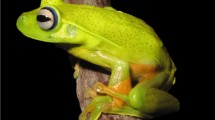Summary
We develop a mechanistic model for nectar feeding in butterflies that integrates the two basic components of the feeding process: the fluid dynamics of nectar flow through the food canal and the contractile mechanics of the muscular, cibarial pump. We use the model to predict the relation between rate of energy intake during feeding and nectar concentration. We then identify nectar concentations that maximize energy intake rates (the optimal concentrations). We illustrate the model using measurements of the food canal and cibarium of Pieris butterflies. The model predicts an overall optimal range of nectar concentration of 31–39% sucrose for butterflies, which is in agreement with previously reported laboratory values. The model also predicts an interaction among the geometries of the food canal, the cibarial cavity, and the cibarial muscles, that allows us to identify the combinations of food canal, cibarium, and muscle dimensions that yield the highest rates of energy intake. Nectar-feeding is “functionally equivalent” in butterflies and hummingbirds: two physically different feeding mechanisms can yield identical energy intake rates. This equivalence results from a mathematical and physical similarity between quasi-steady-state fluid flow in hummingbrid tongues and the force-velocity characteristics of contracting cibarial muscle in butterflies.
Similar content being viewed by others
References
Alexander RMcN (1985) The maximum forces exerted by animals. J Exp Biol 115:231–238
Baker I, Baker HG (1982) Some constituents of floral nectars of Erythrina in relation to pollinators and systematics. Alertonia 4:25–37
Bird RB, Stewart WE, Lightfoot EN (1960) Transport Phenomena. John Wiley and Sons, New York
Eastham LES, Eassa YEE (1955) The feeding mechanism of the butterfly Pieris brassicae L. Phil Trans Roy Soc 239:1–43
Emerson SB (1984) Morphological variation in frog pectoral girdles: testing alternatives to a traditional adaptive explanation. Evolution 38:376–388
Ewald PW, Williams WA (1982) Function of the bill and tongue in nectar uptake by hummingbirds. Auk 99:573–576
Fung YC (1981) Biomechanics: Mechanical Properties of Living Tissues. Springer, Berlin Heidelberg New York
Hainsworth FR (1973) On the tongue of a hummingbird: its role in the rate and energetics of feeding. Comp Biochem Physiol 46:65–78
Kingsolver JG, Daniel TL (1979) On the mechanics and energetics of nectar feeding in butterflies. J Theor Biol 76:167–179
Kingsolver JG, Daniel TL (1983) Mechanical determinants of nectar feeding strategy in hummingbirds: energetics, tongue morphology, and licking behavior. Oecologia 60:214–226
May PG (1985) Nectar uptake rates and optimal nectar concentrations of two butterfly species. Oecologia 66:381–386
McMahon TA (1984) Muscles, Reflexes, and Locomotion. Princeton University Press, Princeton
Pivnick KA, McNeil JN (1985) Effects of nectar concentration on butterfly feeding: measured feeding rates for Thymelicus lineola (Lepidoptera: Hesperiidae) and a general feeding model for adult Lepdoptera. Oecologia 66:226–237
Prosser CL (1973) Comparative Animal Physiology. W.B. Saunders, Philadelphia
Pyke GH, Waser NM (1981) On the production of dilute nectars by hummingbird and honeyeater flowers. Biotropica 13:260–270
Pyke GH, Pulliam HR, Charnov EL (1977) Optimal foraging: a selective review of theory and tests. Quart Rev Biol 52:137–154
Roubik DW, Buchmann SL (1984) Nectar slection by Melipona and Apis mellifera (Hymenoptera: Apidae) and the ecology of nectar intake by bee colonies in a tropical forest. Oecologia 61:1–10
Snodgrass RE (1935) Principles of Insect Morphology. McGraw-Hill, New York
Tamm S, Gass CL (1986) Enery intake rates and nectar concentration preferences by hummingbirds. Oecologia 70:20–23
Taylor CR (1985) Force development during sustained locomotion: a determinant of gait, speed and metabolic power. J Exp Biol 115:253–262
Author information
Authors and Affiliations
Rights and permissions
About this article
Cite this article
Daniel, T.L., Kingsolver, J.G. & Meyhöfer, E. Mechanical determinants of nectar-feeding energetics in butterflies: muscle mechanics, feeding geometry, and functional equivalence. Oecologia 79, 66–75 (1989). https://doi.org/10.1007/BF00378241
Received:
Issue Date:
DOI: https://doi.org/10.1007/BF00378241




